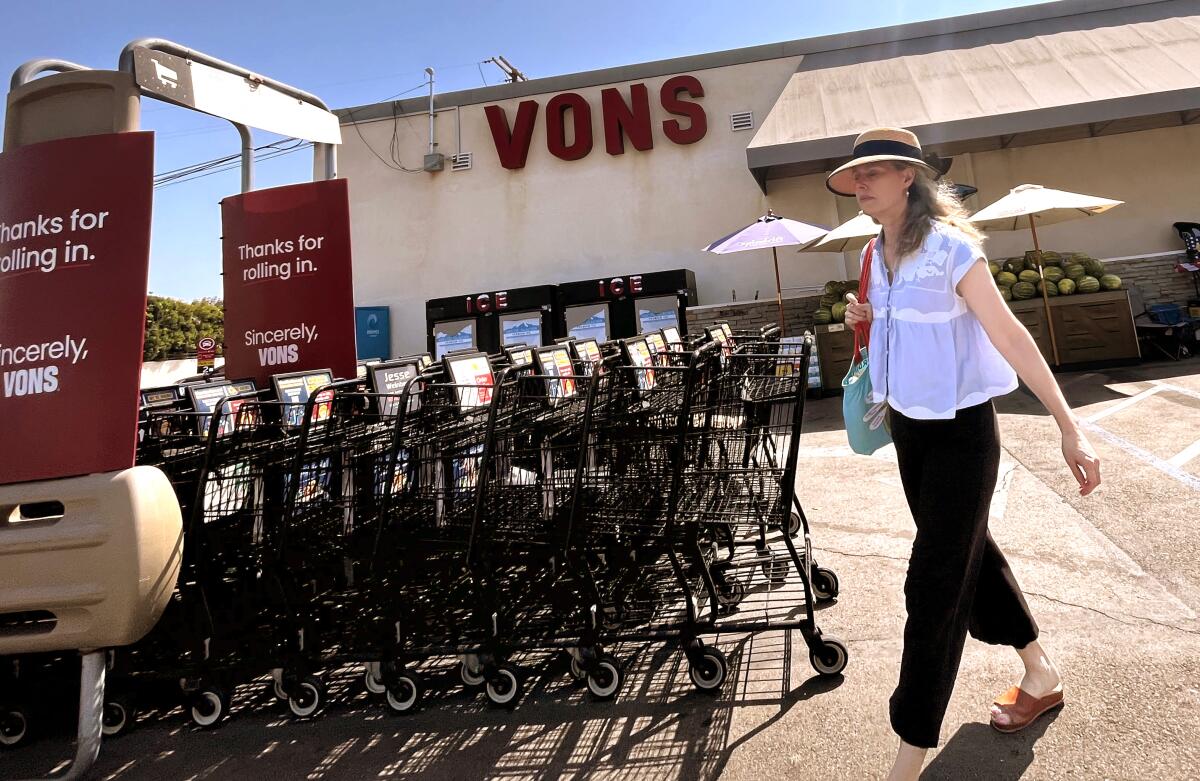How a hoarder has upended a neighborhood and why almost nothing can stop it

- Share via
Good morning. It’s Friday, July 12. Here’s what you need to know to start your day. I’m Harriet Ryan, an investigative reporter for The Times.
- A hoarder upends an L.A. neighborhood.
- These are the Vons, Pavilions, Albertsons to be sold in California under proposed merger.
- Need a hotel near the Hollywood Bowl? 9 cool, Angeleno-approved picks.
- And here’s today’s e-newspaper.
You're reading the Essential California newsletter
Our reporters guide you through our biggest news, features and recommendations every morning
You may occasionally receive promotional content from the Los Angeles Times.
Why almost nothing can stop a hoarder ruining this neighborhood
If you live in Los Angeles, as I do, you probably see evidence of our crisis of untreated mental illness everyday — people suffering beneath underpasses, at bus stops, on sidewalks.
But what if the problem were right next door, a troubled hoarder who turned a plot of property into a dangerous dump? That’s the situation confronting a pair of school teachers in Sun Valley.
Three years ago, Elena Malone and her husband, Joshua Ryan, were like a lot of Angelenos — renting an apartment that was too small for their family and hoping against hope that they could someday afford their own place. Thanks to a lot of scrimping and saving, they bought a 2,000-square-foot house on a half-acre near La Tuna Canyon, a horsey community in the Verdugo Mountains that is one of the city’s most rural enclaves.
The $1.2-million house is lovely — hand-carved cabinetry, exposed beams, an open kitchen and bedrooms for both of their children — with grounds featuring fountains, vegetable gardens, an orchard and mountain views. But these days, their dream home is a prison.

It’s a story that illustrates how entire neighborhoods can suffer alongside the mentally ill and homeless and how difficult these cases are to address, even when everyone from the local LAPD officer to the federal Environmental Protection Agency to the man’s own family agrees there is a problem.
A few months after they moved in, fast-food wrappers started accumulating in the street in front of their house. Before long, there was a pile of junk with more arriving every day — stolen vehicles, car batteries, scrap metal, garbage bags of marijuana, human waste, needles, used condoms, a sex toy and lubricant.
A hoarder next door The man living next door was David Ferrera, 50, whose family described him as a mentally ill hoarder. His mother owned the 6-acre property, and for a time, he had maintained it, even building a house on the land and landscaping the area around it.
But in the 2017 La Tuna Canyon fire — the city’s largest in half a century — Ferrera lost almost everything. A few years later, in another fire, his house burned to the ground. His mother, Mary, an 80-year-old retired school teacher, told me that the fires and other setbacks may have triggered a hoarding instinct in him. “We think that the trauma of all this, and possibly some unresolved past trauma, led to his acquisition of more and more ‘things’ to replace what was lost,” she explained. Ferrera turned the land into an unlicensed dump with more than 100 rusting vehicles, scavenged metal and dangerous chemicals seeping into the ground. When the property became impassable, he took to living in a car in the street in front of Malone’s home.
Agencies pass the buck, a mother enables
Elena Malone has spent almost three years trying to get help from nearly a dozen agencies with almost nothing to show for it. A log she keeps on her computer shows how one agency after another passed the buck. The city Department of Building and Safety sent her to the city Department of Transportation, which told her the street — a fire road — was private property.
The LAPD said it was not authorized to remove cars and trucks blocking the street. The state water board referred Malone to the state Department of Toxic Substances Control. That agency said the EPA was in charge.
In the meanwhile, Malone’s children cannot play in the front yard, and residents live in fear that flammable liquids will fuel a wildfire in the blaze-prone canyon. Malone would love to sell their home, but that seems an impossibility with the dump next door.
Ferrera’s mother, as the landowner, was briefly jailed this year for failure to address the problems, but she says she feels there is little she can do. After she paid for the removal of 21 truckloads of debris, her son filled the space with more junk.
Still, she refuses to kick him off the property or clear all the trash away. “I am an enabler,” she told me. “But that is because I love my son.”
But what about Elena and her family?
My story delves more into their angst and what it’s like to live next to a seemingly intractable problem. I hope you’ll give it a read and let me know what you think — and what could be a possible solution. I can be reached at harriet.ryan@latimes.com
Today’s top stories
Business
- In one L.A. neighborhood, the prospect of losing ‘our little Vons’ hits hard.
- These are the Vons, Pavilions, Albertsons to be sold in California under proposed merger.
- Inflation cools in June, fueling hopes for interest rate cuts in September.
- RIP Redbox. The DVD kiosk business will shut down and fire 1,000 people.
- Allstate is seeking 34% rate increase for California homeowners insurance.
Climate and environment
- L.A. County battery recycler on the verge of becoming California’s next Superfund site.
- Heat waves are growing hotter and more prolonged. What’s driving extreme temperatures?
- ‘A fire year’: California wildfires have burned more than 20 times as much land as last year.
- He reported a possible H5N1 outbreak in dairy cows. It took officials weeks to respond.
Politics
- Biden, in defiant news conference, again vows to remain in the race.
- Democrats could force Biden out under the 25th Amendment — but probably won’t.
- As Kamala Harris rises, Gavin Newsom’s presidential prospects fall — but only in the short term.
More big stories
- Shelley Duvall, scream queen of ‘The Shining’ and a memorable Olive Oyl, dies at 75.
- The battle to save Michael Jackson’s Neverland Ranch from destructive Lake fire.
- Why Leo Pustilnikov is buying 1,500 Skid Row apartments and wants to build thousands more.
- Disbarred in Ohio, he tricked a California law firm into a $250,000 job offer.
- ‘ALF’ star Benji Gregory dies at 46 amid Arizona heat wave.
- Who will be L.A.’s next police chief? A guide.
- Pricey camps. Family favors. Early dashes from work. How do parents survive summer?
- Pat Sajak will come out of short-lived retirement for ‘Celebrity Wheel of Fortune.’
Get unlimited access to the Los Angeles Times. Subscribe here.
Commentary and opinions
- Steve Lopez: ‘Retire and go back under a rock’: Biden loyalists push back on my call for Joe to get tested.
- Michael Hiltzik: Pharmacy middlemen claim to keep prescription prices low. In fact, they’ve cost consumers billions.
- Gustavo Arellano: Reparations for Chavez Ravine families? Not so fast, say some descendants.
- Mark Z. Barabak and Anita Chabria: What should Democrats do now? Two columnists slug it out.
Today’s great reads
Botox is out. Plasma injections are in. But is L.A.’s ‘natural’ anti-aging movement any better? Beauty-conscious consumers are saying “no” to Botox and fillers and opting for natural med spa treatments that may be just as painful — and even more costly and time-consuming.
Other great reads
- Inside the Chargers’ lavish new practice facility in El Segundo.
- Struggling to keep a dry cleaner open in a DTLA ‘zombie’ building.
How can we make this newsletter more useful? Send comments to essentialcalifornia@latimes.com.
For your downtime
Going out
- 🏨 Need a hotel near the Hollywood Bowl? 9 cool, Angeleno-approved picks.
- 💰Tell us: How much did you spend on your summer vacation?
- 🕶️ The hottest pop-ups, drops and art events to add to your summer calendar.
Staying in
- 📺 Review: Adult cartoons ‘Sausage Party’ and ‘Exploding Kittens,’ one charming, one (purposely) not.
- 🧑🍳 Here’s a recipe for peach crisp with thyme.
- ✏️ Get our free daily crossword puzzle, sudoku, word search and arcade games.
And finally ... a great photo
Show us your favorite place in California! We’re running low on submissions. Send us photos that scream California and we may feature them in an edition of Essential California.

Today’s great photo is from Times photographer Brian van der Brug. A man is seen hiking onto the Mesquite Flat Sand Dunes in Death Valley National Park, where temperatures have regularly risen as high as 125 degrees during a recent heat wave.
Have a great day, from the Essential California team
Kevinisha Walker, multiplatform editor and Saturday reporter
Christian Orozco, assistant editor
Stephanie Chavez, deputy metro editor
Karim Doumar, head of newsletters
Check our top stories, topics and the latest articles on latimes.com.
Sign up for Essential California
The most important California stories and recommendations in your inbox every morning.
You may occasionally receive promotional content from the Los Angeles Times.







